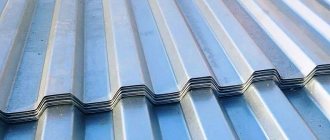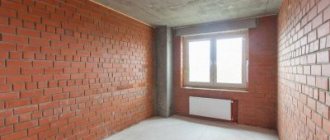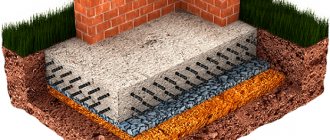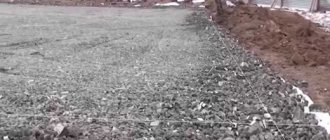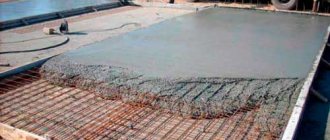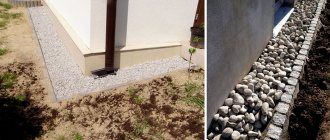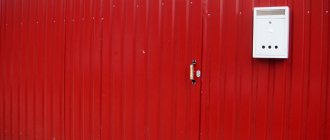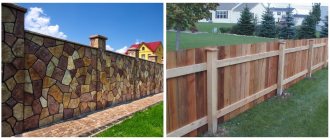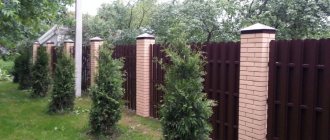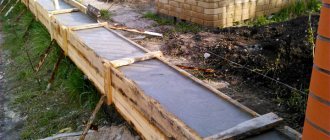A corrugated fence is a solid fence constructed from steel profiled sheets. The peculiarity of such fences is their high windage, because of which it is necessary to think in advance about the durability and strength of the structure. Find out what the optimal thickness of corrugated sheeting for a fence is and other important characteristics of this material in our article.
Types of metal
For the manufacture of corrugated sheets, two types of raw materials are used:
- Galvanized. A layer of zinc with a thickness of 90 microns and a density of 275 g per 1 square meter is applied to the steel. m. Often the manufacturer’s warranty does not exceed 5 years, but in practice such a fence can last up to 10 years. The short period is explained by the volatility of the coating - zinc erodes over time, which makes the steel vulnerable to atmospheric influences. Unpainted sheets can be used for temporary fencing sections as they do not look very attractive.
- Aluminum-galvanized. Components: 55% aluminum, 45% zinc, 1.6% silicon. It is much more resistant to the influence of precipitation and high moisture, which is why the warranty service life exceeds 10 years.
It is worth noting that although painted products will cost more, they will look more attractive.
- How to screw a corrugated sheet onto a fence
- Do-it-yourself fence made of corrugated sheets
Choosing the right corrugated sheet
Which corrugated sheet to choose for the fence? To choose the right fence profile sheet, you should pay attention to the following factors:
Leaf appearance
During transportation, the package of sheets may have been dropped or otherwise damaged. There should be no scratches, bends, creases or dents on both the front and back sides. The sheet must be completely flat and lie without curvature both on a stack of other sheets and on a horizontal surface.
Front surface quality
To check, you need to carefully examine the sheets against the sun. The protective coating should be free of abrasions, micro-scratches, and foreign contamination. The paintwork must be strictly the same color, without blisters, spots or transitions.
It is worth checking the back side of the sheet as well - after all, this is where you will have to look for the entire life of the fence.
Cut quality
At the factory, the corrugated sheets are cut with profiled guillotine shears, which ensure a smooth edge that is exactly the same for all sheets in the package. Small manufacturers sometimes, in order to save money, cut the sheet to the required size using improvised means - jigsaws, band saws and even grinders.
This edge will quickly corrode. The cut line should be smooth, clean and free of burrs.
Availability of film
The best manufacturers protect each sheet of their corrugated sheets from damage with a thin transport film.
Its presence is a sign of the authenticity of the product. The film can be easily removed before installation.
Grades of corrugated sheets suitable for fences, their characteristics
The grades of corrugated sheets are deciphered as follows:
- N – load-bearing, recommended for roofing;
- C - wall, purchased for the construction of fences, cladding the facades of houses, outbuildings;
- NS is universal, can be chosen for any construction, and is also suitable for fencing.
The brand abbreviation is followed by numbers indicating the profile height, sheet width, and steel thickness. These are key indicators when choosing material for a future fence.
Photo: profile sheet designations
Let's look at commonly used options for creating a strong fence.
C8
Considered entry-level and cheap material. Profile height - 8 mm. Used for cladding walls, decorative, temporary fences in regions where the wind is not strong.
C10
This brand of sheets is also inexpensive, but with a greater thickness of steel. The profile height is 10 mm. You can choose any color. It should not be used to install fences with a height of more than 1.5–2 m.
S14, S15
Material with thickened steel. Profile height – 14 and 15 mm. If the area is subject to strong wind loads, then such corrugated sheeting will be a good solution.
S20 (MP20)
The generally accepted marking of sheets is C20, but the designation MP20 is also found. This is the same material. It’s just that the latter was produced in , hence the abbreviation. The working height of the profile is 18 mm. It differs from other brands in the different sizes of trapezoids on both sides. Service life reaches 35 years.
Photo: dimensions of C20 corrugated sheet
C20 is considered universal because it is applicable for both external and internal work (fences, roofs, walls, facades).
Suitable for regions with difficult climatic conditions. Manufacturers began to supply it in three modifications: A, B, R. The first two resist the wind well. The latter copes better with static loads, which is why it is better suited for roof construction.
S21
Optimal material for sloping fences. Profile height - 21 mm. The high strength of profiled sheets allows you to build a reliable fence both for a country house and for industrial production.
How to read corrugated sheet markings
In manufacturers' catalogs, corrugated sheets are marked with letters and numbers - for example, C8. This means that the material is of the wall type, the height of its corrugation is 8 mm.
In the marking:
- the first letter explains the purpose of the profiled sheet: C - wall, N - load-bearing, NS - load-bearing wall or universal; The MP marking is slightly less common - this indicates that it was produced in the city of Lobnya;
- the first number is the height of the corrugation; the larger it is, the stronger the material (and the more expensive it is).
The most durable is the load-bearing one (N) . It can be distinguished by the presence of an additional groove in the center of the corrugation, which increases rigidity. It can be used anywhere, but it is quite expensive, so building a fence from it entails unjustified costs.
Load-bearing-wall (NS) (universal) - an intermediate stage between load-bearing and wall. Its rigidity is higher than that of a wall one, but the price is lower than that of a load-bearing one.
Wall (C) is lightweight and decorative: it is the gold standard in the installation of fences. The low thickness of corrugated board for a fence does not mean that it is of poor quality or fragile, quite the opposite. The rigidity of the fence is added by the depth of the corrugation and a durable frame.
The marking may contain additional numbers, which are written with a hyphen, although not all manufacturers have them:
- the second number is the sheet thickness;
- third - width;
- the fourth is the maximum length.
The manufacturer may provide this data separately in the technical documentation. They will be enough to fully understand what the material is and whether it is suitable for your project.
How to choose the right thickness of corrugated sheeting
This characteristic affects the durability and stability of the entire structure.
For fencing, it is recommended to buy sheets with a thickness of 0.45 to 1 mm. If you have a profiled sheet with a smaller thickness, then installing it as sections is permissible if the metal profile on the frame is securely welded.
Before purchasing, you should measure the material or ask the seller for documents indicating the parameters of the sheets.
Thickness
This is one of the main parameters that determine the suitability of a profile for creating a fence.
The useful width is what can be used to cover the span, and the full width takes into account the possibility of mounting on poles located at a certain distance.
The thickness can be different even for sheets of the same type, and this circumstance should also be taken into account. Even well-attached, but insufficiently dense sheets can lead to the creation of a sailing effect and the profile breaking from its place between strong posts. Therefore, it is better to pay a little more, but take special panels that are denser and imply a more durable fastening.
Some sheet characteristics:
- One of the most common types is C8. Its width is 1150 mm, and the total width is 1200. The thickness of the sheet can be from 0.4 to 0.8 mm. Initially it was conceived as a covering for walls, hence the marking C - wall. It is not very suitable for a fence, because it is a thin and bendable profile, which is not designed to withstand the wind or its gusts, but to be mounted on a thick wall.
- C10 is slightly narrower (by 50 mm) and with less wide stiffening ribs. With the same metal thickness, it can withstand somewhat greater loads due to stiffening ribs with a smaller pitch and the height of the corrugated profile being 10 mm.
- C20 with a stiffener pitch of 137.5 mm and a rib height of 20 mm, despite belonging to category C and the relatively small thickness of the metal (0.45–0.7 mm), is considered an excellent option. This corrugated panel is the best representative of the line of wall panels suitable for installing fencing.
Variety of options
Polymer coating allows you not only to achieve maximum reliability due to the synthetic material, but also to choose it in almost any color. If you properly equip the foundation and take care of the strength of the installed supports, to which you need to correctly attach the profile sheet, then C20 will serve as reliably as special fences.
Which coating is more reliable?
There are many types of protective coating for corrugated sheets. All of them provide the material with stability:
- to corrosion;
- precipitation;
- temperature changes;
- ultraviolet (color does not fade in the sun).
Photo: types of protective coatings for corrugated sheets
The cheapest rolled metal, which manufacturers decided to simply galvanize, has a shiny metallic tint, but this material is not suitable for everyone.
Polymer-coated corrugated sheets are available in a wide selection of colors, which makes them more popular than others.
Separately, it is worth mentioning double-sided corrugated sheeting, which is equally beautiful both from the front and from the inside.
Size of corrugated fence
The profile for delimiting the territory has a number of distinctive parameters. This is not one type of construction product, but a whole line. In its creation, the thickness, height, length, configuration, dimensions of the wave or crest, and the degree of convexity of the relief are taken into account.
Another important factor influencing the choice, in addition to thickness and size, is the protective coating with which the profile is equipped. Before purchasing and installing such a fence, the owner must decide which parameters are suitable for him. Profiled sheets are available in three types: load-bearing, roofing and wall.
It's important to make the right choice
Nevertheless, in these three categories there are certain gradations for sizing. In the price lists that are posted on specialized websites, you can easily navigate by size.
Color spectrum
Available in different colors. Most manufacturers use the Ral table, so that products from different companies are available in the same palette.
Photo: material color palette
The greatest demand is for material made using Printech technology, which perfectly imitates natural stone, brick, wood, and clay. You can also choose a glossy or matte surface.
In addition, many companies began to make European picket fences from corrugated sheets. The top edge of the sheets is specially sharpened to bring it closer in appearance to a classic wooden fence.
The main brands of corrugated sheets produced by TPK Metalroofing Center
Profiled sheeting "S-8"
This type of profile has a wide working surface - 1150 millimeters. This means that less material is used during construction than with other brands of corrugated sheeting. But you should remember about the minimum height of this profile and the thickness of the metal, which limits the scope of use of this profiled sheet.
Profiled sheeting "S-21"
Corrugated sheeting has such a characteristic as the type of overlap. For “S-21” sheets, the overlap occurs along the bottom wave, that is, correctly. If you are looking for fencing material, this is perhaps the best choice. Thanks to its height of 21 millimeters, “S-21” can be used on other objects: facades, ceilings, partitions and even roofing. But when doing roofing work, do not forget about reliable sheathing with a minimum pitch. The symmetry of the profile allows you to work economically, reducing waste to a minimum.
Profiled sheeting "S-44"
This profile is also distinguished by the correct overlap along the lower wave. It is ideal for the construction of fences and gates. You can easily make various partitions, façade cladding, and ceilings from it. Roofing is also one of the possible areas of application of this profiled sheet. But for its installation, it is recommended to pay special attention to reliable sheathing with a minimum step. The symmetry of the profile and its affordable price allow significant savings during construction. Today, profiled sheets of the “S-44” brand have gained enormous popularity in Russia. And the exemplary ratio of quality and price makes it one of the clear market leaders.
Profiled sheeting "NS-10"
For “NS-10” sheets the overlap is also correct, along the bottom wave. It would also be correct to use this profile for the construction of fences, facades and roofs. If the roof slope has a slight slope, then to give additional strength under this corrugated sheet it is better to use sheathing with the minimum possible pitch. The symmetry of this profile allows you to minimize waste and work with it economically, but effectively even in areas of complex shape.
Profiled sheeting "NS-21A"
Today this is one of the most popular types of metal profiles from the Metal Roofing Center. The combination of a beautiful appearance, good rigidity, and low weight made it one of the most versatile and in demand for finishing facades, building roofs and fences. It should be remembered that, depending on the front and back sides, corrugated sheeting “NS-21” is produced in two versions - A and B.
Calculation of the number of sheets per fence
To find out how much material is needed for sections, you need to divide the total length of the fence by the width of the profiled sheet. If the result is required in square meters, then multiply the resulting number by the width and length of one sheet.
It is important to understand that there are two widths: general and installation (working). Moreover, the second type is smaller than the first, because the corrugated sheeting is installed overlapping.
Fence installation diagram
Thickness and quality of steel sheet
What thickness should I choose for corrugated fence so that it lasts long and reliably? The strength of the entire fence depends on this parameter. If the thickness is less than 0.45 mm, then such a sheet can easily deform under the influence of wind load. If you plan to use the fence for a long period, the sheet thickness should be 0.45 mm or higher.
The Russian brand NLMK has excellent value for money. Novolipetsk Metallurgical Plant offers corrugated sheeting with a zinc thickness of 140 g/meter, which is optimal for the construction of fences, gates and gates.
Popular foreign and domestic manufacturers
Let's consider the most reliable manufacturers according to the majority of consumers.
RUUKKI
Finnish manufacturer of building materials. One of the areas of work is the production of corrugated sheets. It has representative offices in many countries. The quality of the product justifies its high cost.
ArcelorMittal
Founded in 1976 in Luxembourg. One of the largest companies in the world producing steel and related materials. It has several representative offices in European countries. There is a research laboratory where scientists are working to improve the technical characteristics of the material.
Emimar
The company is located in Latvia. It was founded back in 2007.
Specializes in the production of:
- sandwich panels;
- siding;
- roof hatches;
- corrugated sheets and other building materials.
Photo: samples of corrugated sheets.
Manufactures products according to individual orders.
Metal Profile
The Russian company is the leader in the domestic production of steel products. Has been working for more than 18 years. There are representative offices and workshops in Belarus and Kazakhstan. Produces corrugated sheets from C8 to H114. Prices for goods are lower than those of foreign companies.
Steele-Plasse
The production line was launched in 1997. Works with large wholesale buyers, construction companies, and individuals. It produces profiled sheets of grades from C8 to H158. Offers a large selection of protective coatings and colors.
Profmetal
Russian manufacturer. The main direction is the production of corrugated sheets. Production is carried out on modern Polish equipment. Model range - from C8 to H114.
Features of use
In recent years, it has become a popular trend to install a fence made of corrugated sheets not only as a temporary fence, as was previously the case. Fencing a large area does not seem to many developers to be as budget-friendly an option as it used to be. And many construction companies first calculate which fence is cheaper.
For industrial needs, you need a simpler and cheaper option. Estimators invest in the calculations material that is more affordable in cost, without taking into account the specific features of pricing.
Capital fence
A common mistake in this case is to look for a cheaper means of delimiting land plots.
And you need to look not for which one is cheaper and less expensive, but which corrugated sheeting for the fence is better.
The main reliability parameter under adverse weather conditions, often more pronounced in open space, is thickness. The denser the metal profile, the less likely it is to damage even a temporary structure for which a foundation is not provided.
Brief characteristics
In temporary fencing of a construction area, its stability depends on:
- the pipe that it was decided to use for the fence (the exact pipe that economical calculations provided for may determine the lack of even minimal stability for the required short period of time);
- The height of the corrugated sheeting is of no small importance (the higher the fence, the greater the likelihood of a collapse by the wind if it is not sufficiently secured and the pillars are secured);
- tearing off the profile is often associated with incompetence in deciding which screws to use to attach the corrugated sheet to the fence, but even for this purpose they do not use high-quality fasteners, but those that are cheaper;
- a correctly poured foundation gives reliability to even the thinnest sheet of material used, but everything again comes down to financing and budgeting;
- making even temporary barriers without taking into account that there must be a strictly prescribed distance between fence posts made of corrugated sheets means dooming the structure in advance to collapse and swaying;
- even the highest quality fence pipe made of corrugated sheets will not hold it if it is not deepened enough and reinforced poorly;
- in choosing a building material, the color of the fence is, of course, important, but the coating that protects the metal from damage is much more important;
- It is better to make a fence soundly right away: this will save money that will be required to restore it if it falls.
Wall option
Private landowners who choose to install corrugated board on the fence approach the problem more responsibly. Buying very expensive material used for a solid roof is both expensive and troublesome to install, but C8 corrugated sheeting is an excellent option.
Recommendations for choosing high-quality profiled sheets
When choosing the thickness of a product, the number indicated on the label does not take into account the protective layer. The optimal indicator is from 0.5 mm.
In addition, it is worth considering the following:
- There should be no unevenness, roughness or dents on the edges of the sheets.
- The color and thickness of the entire batch must be the same.
- Deviations in the width and length of the material exceeding those allowed by GOST 19904-90 are excluded.
- You should not buy corrugated sheeting that has blistered paint or scratches on its surface, even if the price is significantly reduced.
- The place where the sheet is cut should be even and smooth.
- The wave on one sheet should ideally overlap the wave on the previous one.
- It is better if the purchased material is wrapped in film, this way you will protect it from unnecessary scratches during transportation.
At the final stage of the purchase, the seller is obliged to issue a warranty card and a receipt.
Type and quality of protective coating
The wall corrugated sheet used for the construction of a protective fence is a multilayer material. A protection and decorative layer is applied to the steel base.
- Galvanized is the cheapest option. It is suitable for fencing construction sites and warehouses, but is not suitable for a summer house, private home, or store area.
- A corrugated sheet with a zinc-aluminum protective layer is more reliable and looks better than galvanized sheets. It can be coated with oil and alkyd paint to extend its service life.
- Polyester-coated sheets with a thickness of 0.5 mm or more can be installed around a private house. They will withstand any weather conditions and will repel dirt.
- Corrugated sheeting with a pural protective layer is the most expensive. Nothing will happen to this durable and pleasant-looking layer even after 10 years of use. The material is suitable for the construction of permanent fences around residential buildings.
Profiled sheet C8 or C10 for a fence?
S-8 is used for the construction of fences up to 2.2 m high and wall cladding. It has the cheapest price compared to other brands, this is due to the sheet thickness of 0.35mm and profile height of 8mm.
S-10 Has higher rigidity compared to S-8 due to the wave height of 10 mm. They are used for the construction of fences in open areas and for cladding facades.
